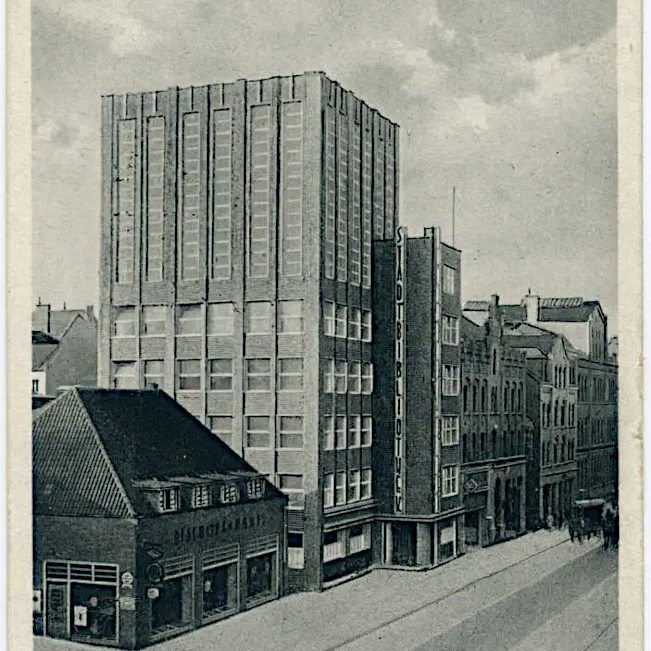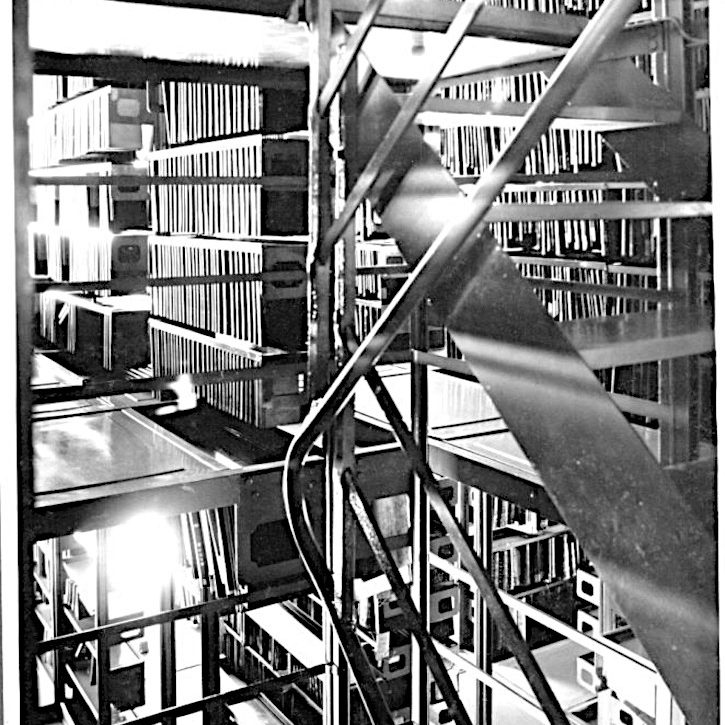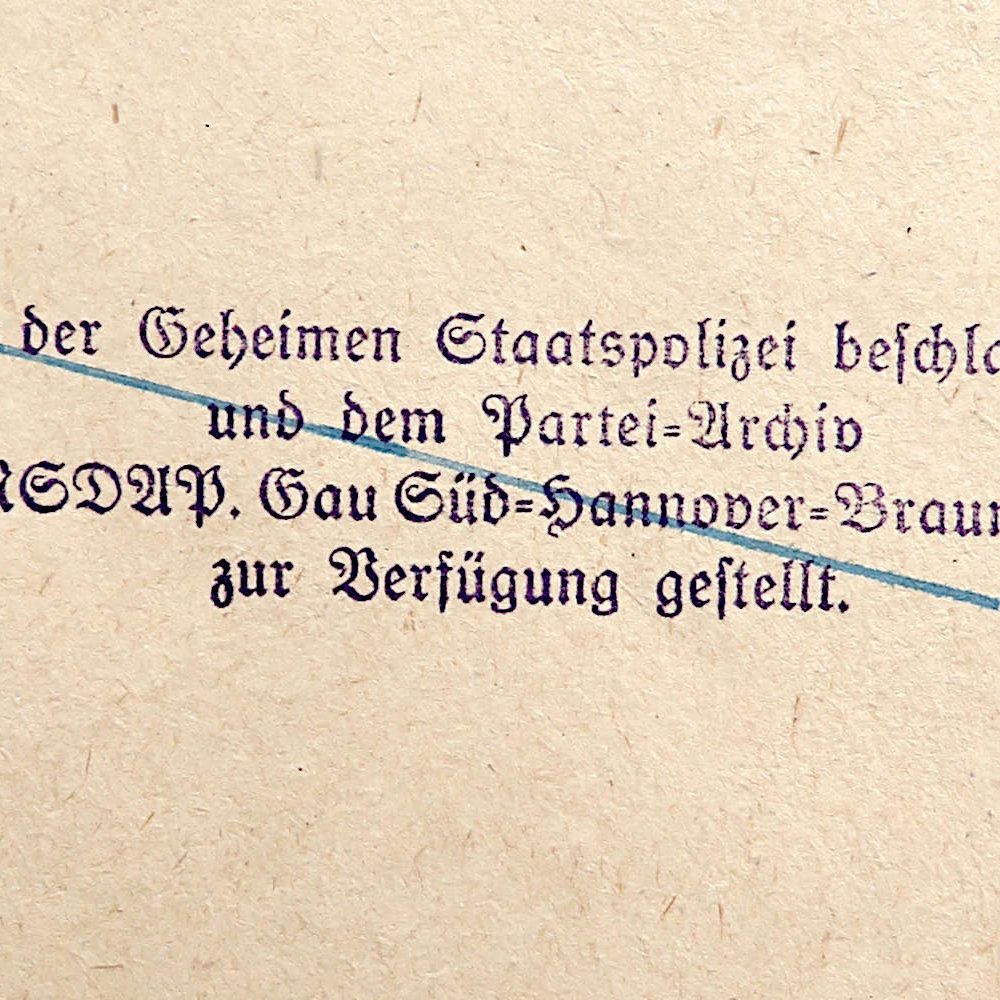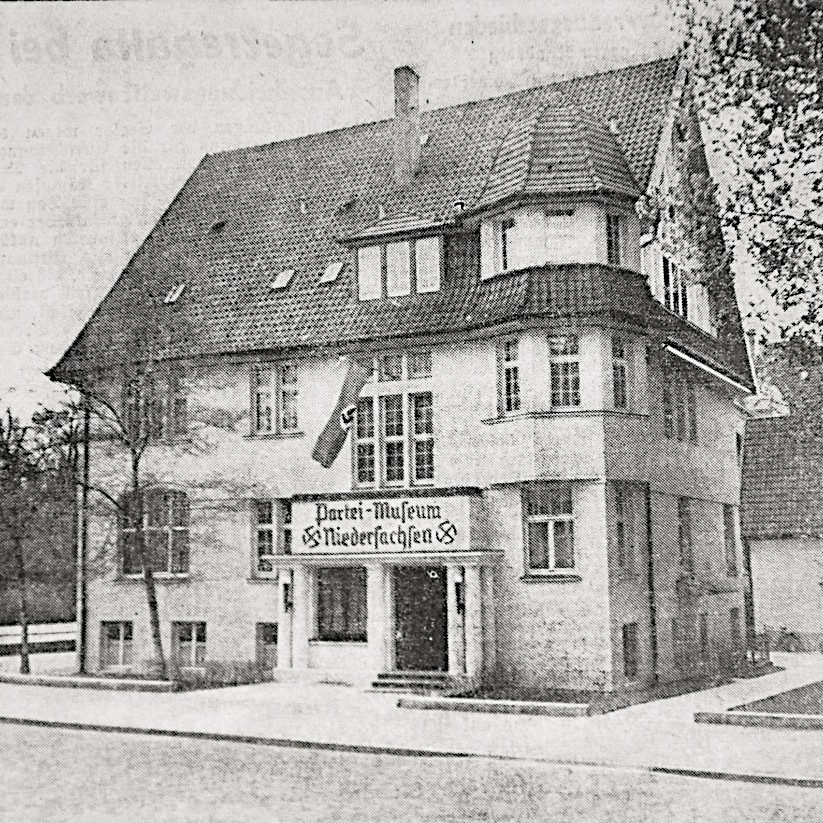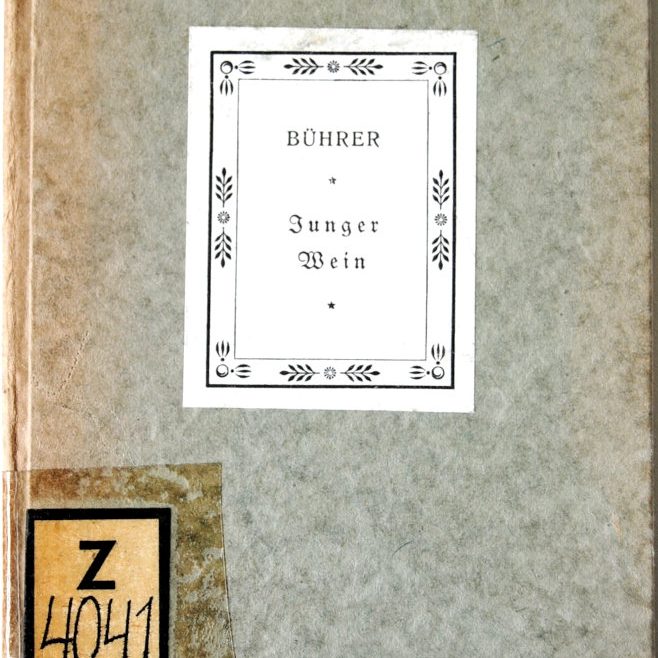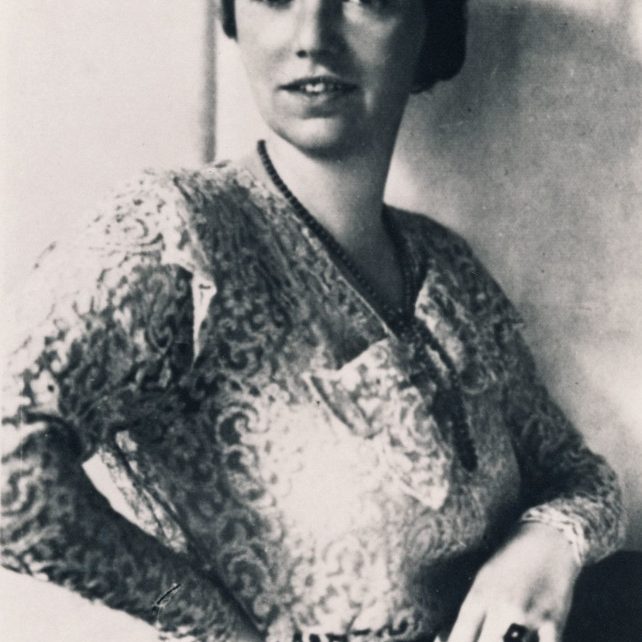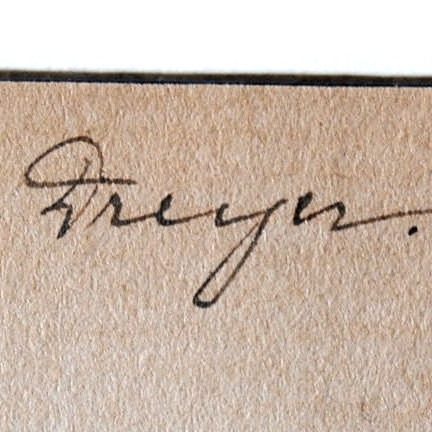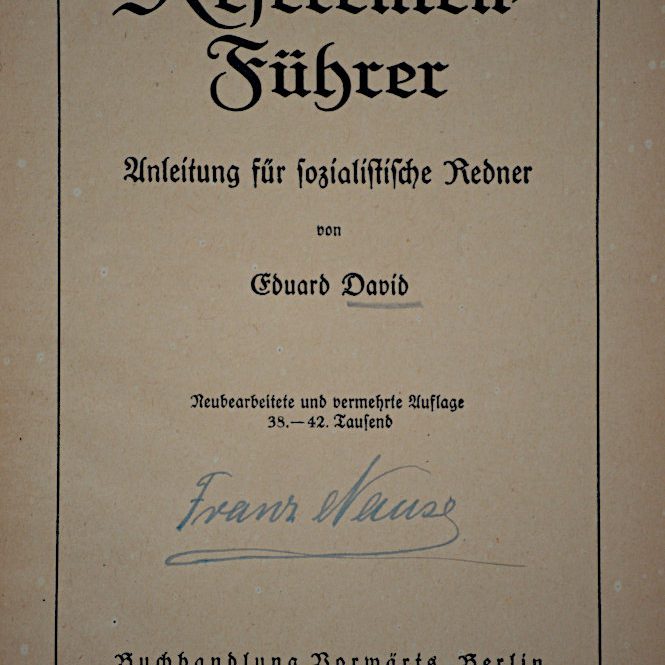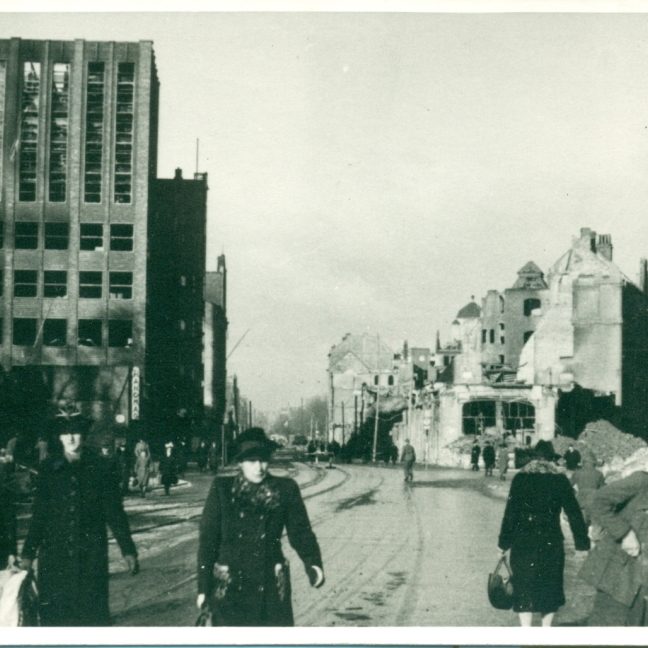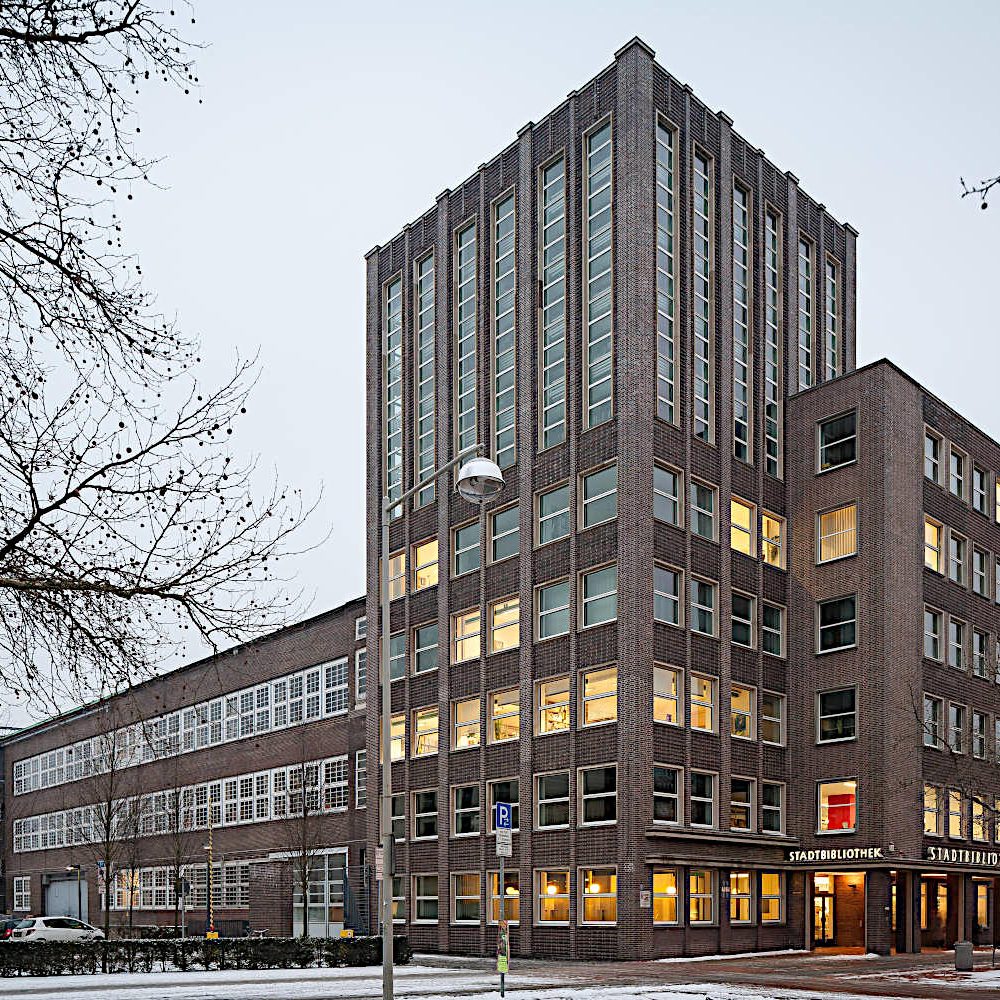Not only works of art, but also individual books or entire private libraries came into the possession of archives, museums and libraries as “Nazi-confiscated cultural property” – including Hannover City Library. The latter makes intensive efforts, in accordance with the criteria of the “Washington Principles” adopted in 1998 with regard to works of art confiscated by the National Socialists, to examine its holdings and return looted property to the rightful owners or their heirs – often a true detective’s work.
![Herkunftsanzeigende Spuren: Exlibris H.[?] Braunsberg; Stempel Johannis-Loge zum Neuen Tempel Braunschweig; Stempel Friedrich Bartens (Eimsen); Exlibris Dr. Johanna Maass. Fotoarchiv Stadtbibliothek Hannover](https://zukunft-heisst-erinnern.de/wp-content/uploads/2021/02/Herkunftsanzeigende-Spuren-in-Buechern.jpg)
The building
The building complex – municipal library, workshop of the municipal theatres and residential building on Maschstraße – is built from 1929 to 1931 according to plans by municipal building officer Karl Elkart and architect Hans Bettex as a late example of “brick expressionism” (a few years later, both lead the National Socialist redevelopment of the old town around the Ballhof). The ten-storey library tower with a front facing Hildesheimer Straße is the first high-rise library building in Europe. The building is badly hit by bombs in October 1943, and large parts of the book collection are burnt. As the nearby headquarters of the Hanover Secret State Police (Gestapo) are burnt out in the same attack, they move into the library building after an interim stay in List. From here they carry out the last deportation of Jewish men and women in February 1945. In 1948, the library was provisionally reopened, and between 1955 and 2003, several renovations and extensions were carried out.
“cheap as antiquarian purchases”….
The city library also profits from the robbery of Jews before and after their deportation – in the language of the financial administration, “utilisation of Jewish property”. After the deportation of the entrepreneur and collector couple Gustav and Therese Rüdenberg to the Riga Ghetto in December 1941, the Chief Finance President offers their valuable book collection, including shelves, to the library for purchase. The couple’s art collection is already stored “for utilisation” in the Kestner Museum.
Only a good third of the 426 books originally purchased by the municipal library survive the war. Gustav and Therese Rüdenberg die under unexplained circumstances in the Holocaust and are declared dead after 1945. When their heirs apply for restitution, a lengthy tug-of-war begins over the books, which “were cheap as antiquarian purchases” – according to library director Friedrich Busch (director 1927 to 1956) without any sense of injustice. When the heirs insisted on the return of the books as the last material traces of their murdered family members, the remaining collection was finally handed over to them in 1950.
Looted property from the NSDAP Gau Archive
In the eyes of the National Socialists, Masonic lodges were a front organisation of “world Jewry”. After 1933, the archive of the NSDAP-Gau Südhannover-Braunschweig with its numerous collections moved into the confiscated lodge house in Herrenstraße: Party files with poster, newspaper and picture collections, but also symbols, objects and archives of the political opponents of the National Socialists confiscated as “enemy archives”. Last but not least, the party archive includes an extensive library of more than 30,000 publications. A large part of this represents looted property: property confiscated by the Gestapo Secret State Police from racially and politically persecuted persons. In 1937, the party founded a “Lodge Museum” in the confiscated lodge house, which was to “educate” the public about the dangerous activities of Freemasonry in Northwest Germany. And in 1939, part of the archive stock is hived off to the new “Party Museum” in Hanover-List.
Villa Sternheim becomes “party museum”
Until April 1933, the Jewish doctor Dr Ludwig Sternheim lives with his family in the beautiful villa on the corner of Waldstraße and Walderseestraße on the edge of the Eilenriede city forest; here he practices, here he writes numerous books on alternative medicine and healthy living. Then the family flees to the Netherlands. The house is acquired by the city and made available to the Hitler Youth in 1935. In 1939, the deputy Gauleiter Kurt Schmalz opens a “Lower Saxony Party Museum” in the house and dedicates it to the “Führer” – the occasion is Adolf Hitler’s 50th birthday. The museum exhibits in particular showpieces from the “fighting days” of the Nazi Party in order to enhance them propagandistically; many school classes are led shudderingly past pacifist or communist writings or books by Jewish writers.
In view of the intensified bombing war, the Gauarchiv and Gaumuseum are closed in 1943 and their holdings are moved to the countryside in Lauenstein am Ith. The Sternheim family is able to survive in hiding in the occupied Netherlands, but does not return to Germany. In 2002, the Free Church of Hanover sets up a children’s and youth centre in the villa and commemorates the history of its Jewish previous owners with an information board.
From the Ith to Hanover City Library: “Lauenstein Collection”
At the end of the war, the holdings of the NSDAP Gauarchiv and Museum are still stored in Lauenstein on the Ith. After looting, they are transferred to the Hanover State Archive, which secures the best pieces and offers the rest to the Hanover City Library. The transfer to the library’s holdings is done quite freely and without the compilation of inventories. In response to enquiries from higher authorities about the “whereabouts of the NSDAP-Gaubücherei”, library director Busch replies in June 1951 that a total of just under 5,000 volumes had been taken over, plus 17 linear metres of political brochures. In the access books of the city library from the post-war years, the (persecution) history of these books is erased: “State Archive Hanover” or “Lauenstein stock” are neutrally named as sources of supply. In the case of direct gifts of books from the Secret State Police to the City Library, however, “Gestapo” is noted as the reference, and in some cases even months after the end of the Nazi regime in May 1945.
A part of the “Lauenstein stock”, about 1500 books and (political) brochures, comes from the municipal library to the Hanover City Archives in 1985. Among them is a speaker’s guide as “Instructions for Socialist Speakers” from the possession of Franz Nause, who died in prison in 1943 as a convicted member of the Hanover resistance group “Socialist Front”.
Search for clues, provenance research, goal of restitution
From August 2017 to October 2020, as part of the research project funded by the German Centre for the Loss of Cultural Property, holdings suspected of being looted that came into the City Library in the early post-war period (1945 to 1955) with a total of 96,363 inventory numbers were examined. In a follow-up project launched in October 2020, the acquisitions from the Nazi period itself (1933 to 1945) will be examined for works seized due to persecution.
For this purpose, books are examined individually for traces of their previous owners, such as handwritten entries, stamps, bookplates or the like. In the case of a positive finding, further questions follow: Are there indications of Nazi persecution of this person, how did this book get into the holdings of the public library, can legal heirs be determined? For the aim of the project is not only to clarify the history of persecution, but also to carry out an act of justice later on: the restitution of the books identified as looted property to the rightful owners or their heirs, insofar as they can be identified.
Additional online information
hannover.de Provenance Research of the State Capital Hannover [in German]
hannover.de Provenance research in the Hanover City Archives [in German]
hannover.de Search for Nazi looted property in the historical holdings of the City Library [in German]
Jenka Fuchs, M.A. / Dr. Carola Schelle-Wolff National Socialist Looted Property Research Project Doubtful Provenances in the Holdings of the Hanover City Library (PDF) [in German]
Jenka Fuchs Searching for clues in the City Library of Hanover. Research on Nazi looted property in acquisitions after 1945. O-Bib 6 (2/2019) [in German]
looted cultural assets NSDAP-Gauarchiv und -museum Südhannover-Braunschweig (NSDAP Gau Archive and Museum South Hanover-Braunschweig)
Evangelical Free Church Hanover Walderseestraße Villa Sternheim [in German]
Further reading: Click here
Texts and images: Michael Pechel

